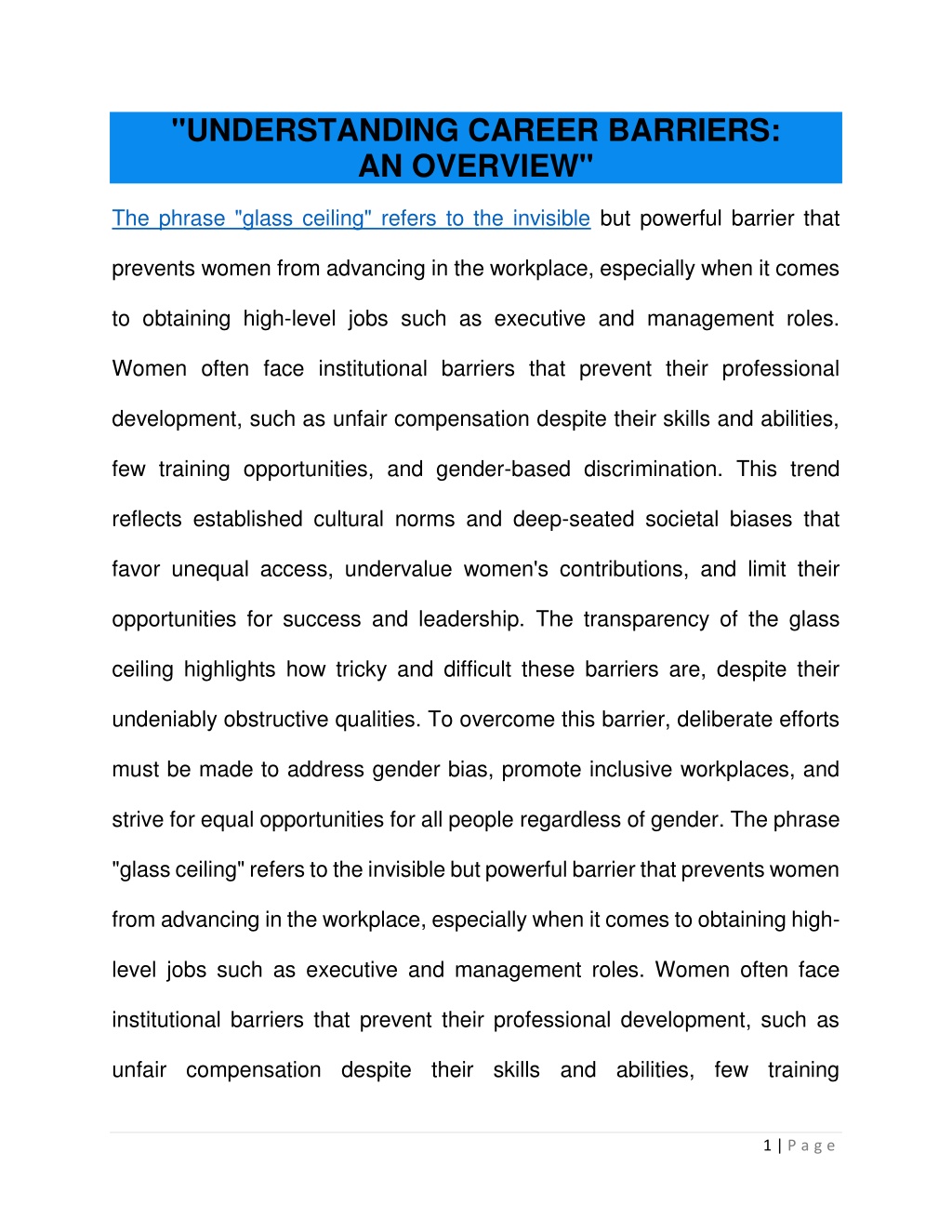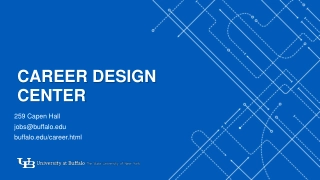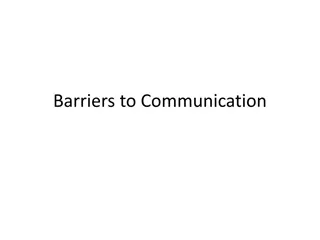
UNDERSTANDING CAREER BARRIERS: AN OVERVIEW"
//seribangash.com/nThe phrase "glass ceiling" refers to the invisible but powerful barrier that prevents women from advancing in the workplace, especially when it comes to obtaining high-level jobs such as executive and management roles. Women
Download Presentation

Please find below an Image/Link to download the presentation.
The content on the website is provided AS IS for your information and personal use only. It may not be sold, licensed, or shared on other websites without obtaining consent from the author. Download presentation by click this link. If you encounter any issues during the download, it is possible that the publisher has removed the file from their server.
E N D
Presentation Transcript
"UNDERSTANDING CAREER BARRIERS: AN OVERVIEW" The phrase "glass ceiling" refers to the invisible but powerful barrier that prevents women from advancing in the workplace, especially when it comes to obtaining high-level jobs such as executive and management roles. Women often face institutional barriers that prevent their professional development, such as unfair compensation despite their skills and abilities, few training opportunities, and gender-based discrimination. This trend reflects established cultural norms and deep-seated societal biases that favor unequal access, undervalue women's contributions, and limit their opportunities for success and leadership. The transparency of the glass ceiling highlights how tricky and difficult these barriers are, despite their undeniably obstructive qualities. To overcome this barrier, deliberate efforts must be made to address gender bias, promote inclusive workplaces, and strive for equal opportunities for all people regardless of gender. The phrase "glass ceiling" refers to the invisible but powerful barrier that prevents women from advancing in the workplace, especially when it comes to obtaining high- level jobs such as executive and management roles. Women often face institutional barriers that prevent their professional development, such as unfair compensation despite their skills and abilities, few training 1 | P a g e
opportunities, and gender-based discrimination. This trend reflects established cultural norms and deep-seated societal biases that favor unequal access, undervalue women's contributions, and limit their opportunities for success and leadership. The transparency of the glass ceiling highlights how tricky and difficult these barriers are, despite their undeniably obstructive qualities. To overcome this barrier, deliberate efforts must be made to address gender bias, promote inclusive workplaces, and strive for equal opportunities for all people regardless of gender. DEFINING THE GLASS CEILING: A BARRIER TO WOMEN'S ADVANCEMENT" The term "glass ceiling" describes the obvious but effective barrier that prevents women from reaching top leadership positions in business. This means the structural barriers, discrimination, and systemic gender biases that prevent women from advancing in their careers despite their skills and abilities. This metaphor highlights the difficulties women face in overcoming established cultural norms and institutional disparities to achieve equality in the workplace. 2 | P a g e
"TRACING THE ORIGINS OF THE GLASS CEILING: A HISTORICAL PERSPECTIVE" Marilyn Lowden coined the term "glass ceiling" in a seminal lecture in 1978 to describe the ubiquitous but often invisible barriers to women's advancement in the workplace. Despite women's abilities and talents, Lowden's concept emphasized the metaphorical idea of a transparent barrier that prevented them from advancing beyond a certain point in their careers. 3 | P a g e
The phrase later became popular when it featured prominently in a 1979 report written by Kathryn Lawrence and Marion Schreiber, both employees of Hewlett-Packard. This initial application in a corporate setting underscored an understanding of the structural barriers that prevented women from achieving top leadership roles. An article published in the Wall Street Journal on April 3, 2015, confirmed the continued relevance of the term, highlighting its importance and resonance in workplace gender disparity discourse. More generally, the term "glass ceiling" has grown and has been adopted to represent a growing understanding of the institutional and structural barriers that prevent women from advancing in their careers. This led to continued efforts to address gender disparities and encourage greater acceptance and diversity in corporate leadership. EXPLORING THE VARIED FORMS OF THE GLASS CEILING" 1. Gender-based: In this kind, women are not given representation in executive roles due to the gender-based glass ceiling. 4 | P a g e
2. Racial or Ethnic: People who identify specific groups or women as minorities, with different racial or ethnic backgrounds, may face hurdles in the progression of their careers. 3. Age-related Glass Ceiling: Due to prejudices against ageism, people of all ages find it difficult to progress in their careers. 4. Educational Glass Ceiling: People with different educational backgrounds find it difficult to advance in certain fields or positions due to priority being given to a particular set of academic credentials. 5. Intersectional Glass Ceiling: This describes how being a woman of color or an LGBTQ+ person can compound the effects of various identity issues. 5 | P a g e
"IDENTIFYING KEY CONTRIBUTORS TO THE GLASS CEILING" 1. Gender Bias: In many companies, rooted prejudices and stereotypes about gender roles and skills still exist. These discriminatory attitudes affect hiring decisions, performance evaluations, and opportunities for advancement, eventually contributing to the gender-based glass ceiling. 2. Stereotypes and Prejudices: Decision-makers may be influenced by racial and ethnic stereotypes and it may result in discriminatory actions that hinder the achievements of people of a certain; Conceptions about competence, work ethics, and leadership potential all play a part in maintaining the glass ceiling. 3. Lack of Diversity Initiatives: Companies that do not place a high priority on the inclusion of diversity, run the risk of an unintentional glass ceiling. A leadership structure that lacks diversity training, mentoring programs, and focused initiatives may be a factor in such a dichotomy. 4. Structural Barriers: Ingrained biases in some organizational structures and industries may sustain the glass barrier. Diversification may be resisted, for instance, in industries that have historically been controlled by one gender or ethnic group. 6 | P a g e
5. Work-Life Imbalance: Gendered expectations regarding carrying responsibilities may disproportionately affect women's career paths. Women are usually less able to balance their responsibilities to their families and careers, which hinders their capacity to pursue and grow in leadership roles. 6. Limited Access to Networks: Opportunities for mentorship and unofficial networks are often essential for job advancement. Barriers to accessing these networks can make the glass ceiling worse for minorities and women. 7 | P a g e
UNPACKING THE SOCIETAL IMPACT OF THE GLASS CEILING 1. Economic Disparities: The glass ceiling contributes to unequal pay and limited access to high-paying jobs for women, resulting in economic disparities between genders. This affects overall productivity and economic growth as talents and skills are underutilized. 2. Gender Stereotypes: The existence of the glass ceiling reinforces societal gender stereotypes, such as the belief that women are less capable leaders, perpetuating inequalities and limiting opportunities for women in various aspects of life. 3. Talent Utilization: The glass ceiling restricts the full usage of talent and skills, leading to missed opportunities for innovation and progress in industries where diversity is crucial for success. 4. Cultural Barriers: Cultural and social norms that uphold the glass ceiling create barriers to gender equality, hindering societal progress towards more inclusive and ethical norms and values. 5. Family Dynamics: The glass ceiling impacts family dynamics by limiting career opportunities for women, which can affect decisions related to 8 | P a g e
childcare and household responsibilities, leading to a strained work-life balance. 6. Educational Choices: The presence of the glass ceiling influences educational aspirations and career choices, shaping the opportunities available to individuals, particularly women, from marginalized gender groups. 7. Health Implications: Facing barriers imposed by the glass ceiling can have negative health consequences, such as stress, burnout, and mental health challenges, impacting overall well-being and quality of life. 8. Intersectionality: The glass ceiling intersects with other dimensions of identity, such as race, ethnicity, and sexual orientation, resulting in compounded inequalities and exclusion for individuals with intersecting marginalized identities. 9. Legal Response: Legal and policy interventions play a critical role in addressing the societal impacts of the glass ceiling by enforcing anti- discrimination laws and promoting gender equity in the workplace. 10. Collective Action: Collective responsibility and advocacy efforts are essential in dismantling the glass ceiling and fostering a fairer and inclusive 9 | P a g e
society for all genders, emphasizing the importance of community engagement and solidarity in driving systemic change. 10 | P a g e
"ANALYZING THE IMPACT OF THE GLASS CEILING ON INDIVIDUALS AND ORGANIZATIONS" Impacts on Individuals 1. Career Advancement: The glass ceiling restricts prospects for advancement, especially into higher-level leadership roles, which can impede an individual's ability to flourish professionally. 2. Salary Disparity: In light of the glass ceiling, women usually receive lower compensation than males, which causes gaps in their income and lower earning potential throughout their careers. 3. Job satisfaction: People who believe their efforts are devalued and unappreciated may experience a decline in job happiness and morale because of their inability to break through the glass ceiling. 4. Stress and Burnout: The strain of dealing with structural obstacles to job advancement may cause stress and burnout, which can have a detrimental effect on one's mental and physical well-being. Goals for a Career: The glass ceiling may deter people from pursuing ambitious career goals and aspirations, especially women, which could lead to a loss of talent and potential in the workforce. 11 | P a g e
5. Career Aspirations: The glass ceiling may deter people from pursuing high career goals and aspirations, especially women. This could result in a loss of skill and potential in the industry. IMPACTS ON ORGANIZATIONS 12 | P a g e
1. Talent Retention: If talented people believe that there are insufficient opportunities for advancement due to the "glass ceiling," especially women, organizations may find it difficult to keep them on board. This can lead to a loss of significant human capital. 2. Innovation and creativity: Because multiple perspectives are necessary for problem solving and decision making, a glass ceiling can hinder innovation and creativity within companies due to a lack of diversity in leadership roles. 3. Reputation and brand image: Companies with clear glass ceilings risk losing their reputation as people perceive them as less progressive and inclusive, making it harder for them to attract top talent and maintain customers. It becomes difficult to hold. 4. Employee engagement: When workers believe there are unfair barriers to advancement, they may become disengaged and disengaged, reducing productivity and efficiency within the company. 5. Legal and Compliance Risks: Organizations that ignore glass ceiling issues risk discrimination lawsuits and reputational damage, among other legal and compliance challenges. 13 | P a g e
"STRATEGIES FOR SHATTERING THE GLASS CEILING" 1. Promoting Gender Diversity Initiatives: Initiatives to promote gender diversity aimed at increasing the representation of women in leadership roles and at all organizational levels should be a priority for organizations. This may include setting specific targets or quotas for the proportion of women in the workforce, as well as devising policies to encourage the recruitment, promotion, and retention of women in the workforce. 2. Establish Transparent Promotion Criteria: Make sure that the criteria for promotions are clear, objective, and understandable to all staff members. Implementation of a merit-based evaluation process serves to reduce bias and guarantees that promotions are given based on an individual's abilities, credentials, and achievements rather than personal attributes. 3. Provide opportunities for leadership development: Provide women- only leadership development programs that help them become more competent, confident, and prepared for senior leadership positions. These programs can provide, among other things, networking opportunities, coaching, mentoring, and training in communication, negotiation, and strategic thinking. 14 | P a g e
4. Addressing Implicit Bias: Develop training initiatives to increase knowledge of unconscious bias and how it affects promotion and performance evaluation decision-making processes. To create a more inclusive and fair workplace, managers and staff should be encouraged to recognize and confront their biases. 5. Encourage sponsorship and mentoring initiatives: Create government programs for sponsorship and mentoring to give women access to advice, advocacy, and support from top organizational leaders. While sponsors may aggressively emphasize their professional development, potential mentors may provide guidance, criticism, and encouragement on their careers. 6. Flexible workplace regulations: Adopt flexible work arrangements, such as remote work options, flexible scheduling, and parental leave policies, to meet the varying demands and responsibilities of your workforce. Flexible work schedules encourage work-life balance for women and make it easier for them to stay in and advance in the workforce. 7. Disrupting cultural norms and stereotypes: Create a workplace culture that challenges cultural conventions and preconceived notions about gender roles and expectations. Promote transparent communication and guidelines 15 | P a g e
regarding implicit bias, gender equality, and inclusive leadership to foster a more motivating and welcoming workplace for all staff members. 8. Measurement and Accountability: Hold managers and leaders accountable for encouraging gender diversity and inclusion in their groups and divisions. Create metrics and key performance indicators (KPIs) to monitor the achievement of gender equality objectives, and evaluate diversity programs on a regular basis. 9. Promote a work-life relationship: Help employees achieve work-life integration by offering programs and benefits that focus on their overall well- being, such as childcare assistance, mental health resources, and wellness. Welfare activities. When a supportive workplace culture is established that values and accommodates the personal and professional needs of workers, retention and engagement increase. 10. Encourage policy reforms: Promote policy changes, such as pay equity laws, family-friendly regulations, and anti-discrimination laws, to remove systemic barriers to gender equality at the organizational, industry, and government levels. Collaborate with legislators, business associations, and other stakeholders to bring about meaningful change and create a gender-neutral society. 16 | P a g e
LEGAL PROTECTIONS AGAINST GLASS CEILING DISCRIMINATION" International Treaties: 1. Convention on the Elimination of All Forms of Discrimination Against Women (CEDAW): Adopted by the United Nations General Assembly in 1979, CEDAW is often described as an international bill of rights for women. It obliges countries that have ratified the convention to act to remove discrimination against women in all areas of life, including employment and leadership. 2. International Labor Organization (ILO) Conventions: The ILO has several conventions addressing gender equality and non-discrimination in employment. For example, Convention No. 111 on Discrimination in Employment and Occupation prohibits discrimination based on gender in recruitment, promotion, and working conditions 17 | P a g e
INTERNATIONAL ORGANIZATIONS: 1. United Nations Women (UN Women): UN Women is the United Nations entity dedicated to gender equality and the empowerment of women. It works globally to advance women's rights, including promoting policies and programs aimed at breaking the glass ceiling and achieving gender parity in leadership positions. 2. International Labour Organization (ILO): The ILO is a specialized agency of the United Nations that sets international labor standards and promotes decent work for all. It works to eliminate discrimination in employment and advance gender equality through research, advocacy, and technical assistance to member states. 18 | P a g e
3. Organization for Economic Co-operation and Development (OECD): The OECD promotes policies to improve the economic and social well-being of people around the world. It conducts research and guides member countries on promoting gender equality in the workforce, including addressing barriers such as the glass ceiling. 4. European Union (EU) Institutions: The European Union has several institutions and bodies dedicated to promoting gender equality and combating discrimination, including the European Institute for Gender Equality (EIGE) and the European Commission's Directorate General for Justice and Consumers. 5. World Economic Forum (WEF): The WEF works to promote public- private cooperation on global issues, including gender equality. It publishes the annual Global Gender Gap Report, which assesses progress towards gender parity in various areas, including economic participation and opportunity. NATIONAL AND REGIONAL ORGANIZATIONS 1. National Human Rights Institutions (NHRIs): Many countries have NHRIs responsible for promoting and protecting human rights, including gender equality. They may investigate, provide advocacy, and offer 19 | P a g e
recommendations to address discrimination, including barriers such as the glass ceiling. 2. Women's Rights Organizations: Numerous non-governmental organizations (NGOs) and civil society groups advocate for women's rights and gender equality at national, regional, and international levels. They often conduct research, raise awareness, and lobby for policy changes to address issues such as the glass ceiling and promote women's leadership. "INDIVIDUAL ACTION FOR GLASS CEILING DISMANTLING" 1. Self-Representation: By aggressively looking for chances to progress, communicating their professional objectives to supervisors, and pushing for promotions, pay increases, and leadership roles, people may speak out for themselves. 2. Ongoing Education and Training: Invest in lifelong learning and skill development to improve your credentials and suitability for opportunities at a higher level. This can entail going for extra coursework, credentials, or training courses that are pertinent to one's professional objectives. 3. Creating a Network of Support: Build a solid support system of peers, sponsors, mentors, and allies who can offer advice, criticism, and advocacy 20 | P a g e
when navigating opportunities and obstacles in your profession. Look for sponsors and mentors who can provide guidance and encouragement in overcoming obstacles and moving up the organizational ladder. 4. Challenging Stereotypes and Gender Bias: Speak out against discriminatory practices and promote inclusive policies and practices that encourage gender equality to combat gender bias and stereotypes in the workplace. Recognize your unconscious prejudices and work to foster an environment where all workers are treated equally and with respect. 5. Seeking Feedback and Mentorship: Actively look for input from mentors, colleagues, and supervisors to pinpoint areas that need work and places where you may advance. Actively interact with mentors and ask for advice on how to overcome obstacles in your job and move up the organizational ladder. 6. Providing Assistance to Other Women: Provide sponsorship, encouragement, and mentoring to other women in the workplace to help and elevate them. Establish avenues for women to collaborate, network, and advance their careers to cultivate a welcoming and inclusive workplace. 21 | P a g e
7. Setting a Good Example: Set a good example for others to follow by acting with competence, professionalism, and strong leadership in all facets of your career. Act as an inspiration to other women, encouraging them to achieve their professional aspirations with courage and tenacity. 8. Promoting Changes in Policy: Speak up in favor of workplace practices and regulations that advance gender parity and help women grow, such as flexible work schedules, parental leave guidelines, and open promotion procedures. Take part in diversity and inclusion programs or employee resource groups to promote positive change inside the company. 9. Visibility and Networking: To increase your connections and exposure in your field, cultivate a robust professional network, and take part in industry events, conferences, and networking opportunities. Bearing a strong personal brand and professional reputation might help you get more leadership and career progression possibilities. 10. Keeping Going Despite Adversity: Continue to be strong and unwavering in the pursuit of your professional ambitions in the face of obstacles and disappointments. Remain committed to your principles, strengths, and long-term goals; don't let the glass ceiling's limitations stop 22 | P a g e
you. Your tenacity and resolve can serve as an example to others and help break down obstacles for upcoming generations. "THE ROLE OF EDUCATION AND AWARENESS IN ADDRESSING THE GLASS CEILING" 1. Encouraging Gender Equality: Education contributes to a greater understanding of the glass ceiling's existence and its effects on women's job advancement. It promotes a greater awareness of the stereotypes and gender biases that support workplace inequity. 2. Building Confidence and Skills: Education gives people especially women the information, abilities, and self-assurance they need to overcome obstacles and seize opportunities for career progress. 3. Promoting Change: People who are informed and educated are better able to push for organizational projects and legislative reforms that advance gender equality and shatter the glass ceiling. 4. Establishing Inclusive Work Environments: Education, by encouraging equity, respect, and equal chances for all workers, regardless of gender, promotes an inclusive and diverse work culture. 23 | P a g e
5. Empowering Women: Education enables women to break through the glass ceiling and realize their full professional potential by allowing them to pursue further education, professional development, and leadership positions. "THE UNIVERSALITY OF THE GLASS CEILING: BEYOND INDUSTRY BOUNDARIES" No, the Glass Ceiling may exist across various industries and sectors, inclusive of all and not only limited to finance, technology, healthcare, academia, and government. The glass ceiling is a universal problem that affects women's advancement in a variety of areas worldwide and cuts across industry borders. It reflects the institutionalized prejudices and restrictions that prevent women from achieving leadership roles in any field they choose. This universality, which calls for cross-sectoral actions highlights the necessity of addressing gender disparity and establishing inclusive workplaces where everyone has equal possibilities for career growth. "PROMOTING EQUALITY AND INCLUSION: STEPS TOWARDS PROGRESS" 1. Guarantee Fair Compensation: Offer workers a fair wage regardless of their gender, race, or other identifying traits. 24 | P a g e
2. Promote Inclusive Workplaces: Provide equal career opportunities and diversity support for all employees. 3. Handle Bias: To reduce inadvertent biases in the processes of advancement and selection, offer training. 4. Establish Mentorship Programs: Help underrepresented groups advance in their careers by offering sponsorship and mentorship opportunities. 5. Set Diversity Goals: Hold leadership accountable for achieving measurable diversity targets. 6. Establish Flexible Work Policies: Implement flexible work schedules to accommodate a variety of requirements and promote work-life balance. 7. Encourage Open Communication: Provide channels for employees to discuss concerns about prejudice and discrimination. 8. Provide Leadership Development: Establish a Range of Leadership Career Pathways to Prepare Individuals for Senior Roles. 9. Challenge Stereotypes: Disrupt gender norms and stereotypes in the workplace by educating people and raising awareness through campaigns. 25 | P a g e
10. Promote Policy Changes: Support legislative and policy measures to address systemic inequalities and enhance equal chances. The term "glass ceiling" describes the obvious but effective barrier that prevents women from reaching top leadership positions in business. This means the structural barriers, discrimination, and systemic gender biases that prevent women from advancing in their careers despite their skills and abilities. This metaphor highlights the difficulties women face in overcoming established cultural norms and institutional disparities to achieve equality in the workplace. For more business blogs please : https://seribangash.com/ https://seribangash.com/glass-ceiling-the-invisible-barrier-for-womens/ https://seribangash.com/cottage-industry-tales-stories-of-success/ https://seribangash.com/barber-shop-business-complete-guide-for-beginners/ https://seribangash.com/computer-accessories-shop-8-innovative-ideas/ https://seribangash.com/car-decoration-business-start-profitable-venture/ 26 | P a g e






















